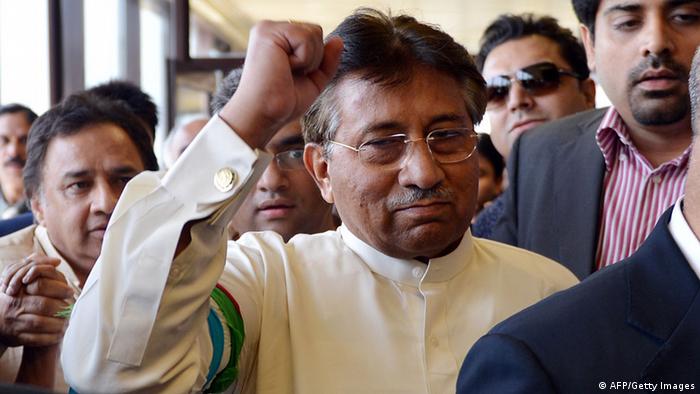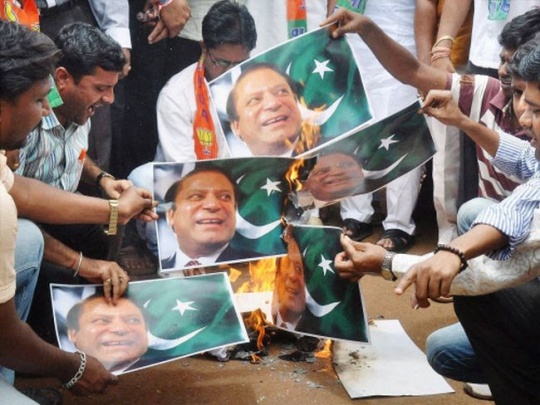
About two years ago, a British military attaché in Islamabad was dismissed after he “lost the confidence of the British High Commission” following what London called his “inappropriate relationship” with a Pakistani female ‘spy’.
Brigadier Andrew Durcan, 56, was recalled in January 2007.
All hell broke loose after Aroosa Alam of an Islamabad daily, Pakistan Observer, ventured with what she claimed was an expose on how the drama involving the British military attache and the female spy played out.
Alam pointed to a certain research fellow, who happens to work for the ISS as the spy in question. This infuriated Dr Shireen Mazari, the ISS boss, who then went to town with a rejoinder that attempted to cut Alam down to size, but which in turn, drew the fury of the offended daily. Credibility was at stake, after all.
It is no secret that in diplomatic missions, some officials serve time for work other than their stated job-description. It is quite probable that Brigadier Durcan had a few skeletons in his cupboard, which is, in part explained by his rather secretive dismissal following a “loss of confidence” at the High Commission. Islamabad’s statement that it was never informed of the decision is, again, a pointer.
British Ministry of Defence, which seconds senior officers to the Foreign Office as military attaches in embassies around the world, confirmed the dismissal but declined to discuss the disgraced official’s future postings or whereabouts.
“The High Commissioner in Islamabad considered his platonic friendship with a Pakistani national inappropriate and, as a result, lost confidence in him. He has been investigated and cleared over potential breaches of security,” is what a statement from the ministry said following the revelation.
The married Durcan is a former commander of the Gordon Highlanders, 52nd Lowland Brigade and deputy inspector-general of the Territorial Army. He was nicknamed “the tartan barrel” by officers under his command in Scotland because of his girth.
But to most Pakistanis, it is the alleged involvement of their compatriot, a female at that, which is the most intriguing element of the soap opera.
Aroosa Alam, the daredevil reporter, decided to put them out of their misery with this expose:
“Careful and thorough investigation and a number of background interviews with military diplomats close to Brigadier Durcan revealed that a research fellow from Institute of Strategic Studies is the lady behind the whole affair. “Holding dual nationality, one Pakistani and other British, Ms M K, has been associated with the Institute for many years. She deals with a number of defence-related issues and has written many research papers particularly on conflict resolution, non-proliferation, and EU.  “She frequently travelled between England and Pakistan. In Pakistan, she sought many interviews with various high-level defence officials even in Pakistani military hierarchy. She came under suspicion by M16 undercovers in Islamabad mission when she sought interviews with defence officials of the High Commission to be used in her research papers. “According to sources, she would ask some very pointed and pertinent questions. But when she went back she never used these interviews and wrote nothing on these issues. Intelligence authorities in the High Commission were then alarmed and started suspecting that these questions were asked by her for not her own research papers but for the consumption of some one else. This was some time last fall. The girl and the Brigadier were monitored. Phones were bugged. Even the room and the house of the British Military Attache were bugged. “Some sources claimed that some filming was also done to prepare incriminating evidence. Both were also spotted intimately together at some social functions. Sources claimed that the Brigadier also travelled to England many times to spend time with her and his engagements in England were also watched and closely monitored. “A team arrived from London in early January this year after Christmas holidays and the Brigadier was confronted for the first time about the status of his relations with the young lady. He was asked to report back to London where, according to sources, he appeared before a three-member military tribunal along with the internal inquiry report, and evidence based on phonic conversations and perhaps with some pictures”.
“She frequently travelled between England and Pakistan. In Pakistan, she sought many interviews with various high-level defence officials even in Pakistani military hierarchy. She came under suspicion by M16 undercovers in Islamabad mission when she sought interviews with defence officials of the High Commission to be used in her research papers. “According to sources, she would ask some very pointed and pertinent questions. But when she went back she never used these interviews and wrote nothing on these issues. Intelligence authorities in the High Commission were then alarmed and started suspecting that these questions were asked by her for not her own research papers but for the consumption of some one else. This was some time last fall. The girl and the Brigadier were monitored. Phones were bugged. Even the room and the house of the British Military Attache were bugged. “Some sources claimed that some filming was also done to prepare incriminating evidence. Both were also spotted intimately together at some social functions. Sources claimed that the Brigadier also travelled to England many times to spend time with her and his engagements in England were also watched and closely monitored. “A team arrived from London in early January this year after Christmas holidays and the Brigadier was confronted for the first time about the status of his relations with the young lady. He was asked to report back to London where, according to sources, he appeared before a three-member military tribunal along with the internal inquiry report, and evidence based on phonic conversations and perhaps with some pictures”.
 Aroosa Alam drew a swift riposte from Mazari, who called a press conference the very next day, refuting the allegations point-by-point. She said although the research fellow mentioned in Alam’s report did work for ISS, all references to her subordinate’s name – right from the work specifics to foreign travel and dangerous liaisons with the disgraced British official – were factually wrong.
Aroosa Alam drew a swift riposte from Mazari, who called a press conference the very next day, refuting the allegations point-by-point. She said although the research fellow mentioned in Alam’s report did work for ISS, all references to her subordinate’s name – right from the work specifics to foreign travel and dangerous liaisons with the disgraced British official – were factually wrong.
Mazari was clinical in her assertion and rounded off the rearguard by demanding an apology from both the reporter and her paper, failing which she threatened to seek legal redress.
However, her charge that the paper was undermining national interests and becoming a tool for vested interests, drew a scathing rejoinder from the paper, which made no secret of its displeasure by stating that it did not need a sermon from someone under the microscope.
In fact, it went on to suggest that it had done a favour to Mazari by publishing what it did since that “put an end to wild guesses being made in the city about some of the known media-related female academics, including Dr Mazari herself, for being the lady in question”.
The prime time battle was apparently, won by Mazari, when the paper finally, issued a front-paged “clarification” by its editor, regretting the “inadvertent” nomination of the ‘spy’ (MK) in the story, which it denied was true.
It has now emerged that the alleged ‘spy’ is, indeed, not the one named in Alam’s controversial story but someone else. However, some contents of her story, apparently, do hold ground.
For instance, the incriminating evidence one got to see clearly belies London’s claim that its official did not have the kind of relations with the ‘spy’ that a certain Bill Clinton allegedly had with the most known intern in history.
Palwasha*, 18-year old Afghani girl, has been a commercial sex-worker since she was 14. A year later, she was forced to marry her rapist, who was also addicted to drugs. Then she was taken to Iran and forced into commercial sex work to make money for her husband. “He used to beat me up very badly every day besides forcing me to make money for him,” she was quoted as saying in the AIHRC report. “After a year or so he sold me to an Iranian drug seller for a huge amount of money before my family found out about it in Afghanistan and my mother came to Iran to rescue me.”
The cause of the prevailing international trafficking on all continents, stems from the demand. Like others trades, be it arm-dealing, drug trafficking, the human trafficking is also an illicit market and is controlled by the basic economic theories of supply and demand. As is common knowledge in the field of economics, once the demand lowers so does the supply.
Unfortunately, no one wants to go anywhere near the sensitive, controversial topic of “demand.” There are very few international organizations, government programs or NGOs that even touch on the topic of demand in human trafficking and the organizations that do focus on demand tend to center their efforts on abolishing sex trafficking. Amongst the handful of organizations that are unanimously in agreement to eradicate the demand and are concentrating their efforts for countering the demand side of human-sex-trafficking are the STOP DEMAND, THE Sage Project and Global Centurion.
It’s essential to truly change the mindset of the slave buyer to eradicate modern-day slavery and end the demand for slaves. And to end demand, involved people (men and women both) need to be held accountable for their participation in buying women and children for sex.
Understanding patterns of organized criminal networks are also important to consider. The situational context is vital to also develop awareness of the recruitment practices. Many girls like Palwasha” and others fall into the hands of human-traffickers due to their vulnerable conditions such as poverty, illiteracy and impoverished house-holds.
Their recruitment usually takes place by “agents” or middle-persons (more than 65% are women) that lure their victims through girls through force (drugging/kidnapping); or coercion via promises of fake opportunities or boyfriends who trick young girls in to running away with them.
In starkly poor villages of Afghanistan, Pakistan and other countries, the women agents visit houses and speak face-to-face with parents, elderly establishing a trust within a community. This helps in getting significant large number of children, sometimes an extortion fee is also taken from the victim’s family to make think that their children will get better rewards after reaching their destinations or this amount will cover their basic needs.
Being a woman, it disgusts me to observe that more than often “women” are working as trust agents that engage to establish themselves quickly within communities.
At Islamabad, in the previous years, the dark side of diplomacy has also come to the surface. When media broke out the story that consular staff at the Switzerland Embassy was involved in a human trafficking racket. Switzerland immediately replaced all its embassy and consular staff in Pakistan. It also shut down its visa-section at Islamabad, that followed a Pakistani investigation into the illegal Swiss visas that has led to a number of arrests.
Switzerland also launched visa fraud investigations in countries Oman, Peru, Russia, Nigeria, Serbia and Eritrea. These issues came to the surface after local media started highlighting the plight of Pakistani visa applicants complaining about the various forms of harassment by Swiss embassy officials.
A few weeks ago, Pakistan Embassy in Libya sent the Foreign Ministry an official letter that alleged that Federal Investigation Agency’s (FIA) Immigration department in Islamabad, is involved in human trafficking. The embassy provided sustainable evidence to back its claims that travel documents were being used for opening bogus vacancies in fake companies, and added that the officials at FIA Immigration department in Islamabad are charging between Rs25,000-50,000 (150-350 EURO) per person to smuggle them abroad.
The letter added that hundreds of Pakistanis contact the embassy every day saying that they have no money to eat and appeal to be sent back to Pakistan. This is why, the letter urged, a ban should be imposed immediately on all people traveling to Libya and action should be taken against FIA officials involved in the fraud. Further more, the report claims that thousands of Pakistanis sent illegally to various places across the world are dwelling in jails, fallen into hands of trafficking networks and being meted out inhumanly treatment. It adds that countless have already died in the dire conditions.
On one-hand the human-flesh trade continues, but inside Pakistan, the prominent internationally recognized campaigner of human rights, Ansar Burney continues to serve are a whistle-blower.
Burney is a man with a mission. The mission that is not so impossible includes crimes against humanity, degradation, child abuse, sex-slavery, human trafficking and other more subtle forms of human and civil rights violations without any discrimination or affiliation.
He has been working on issues of sexual slavery in Pakistan, the Middle East and Africa for two decades now. During this time, with assistance from the various governments and authorities, through his organization the Ansar Burney Trust, he has secured the release of thousands of persons from false imprisonment and slavery across the world; these have included young girls sold in the sex trade and young children used for modern-day slavery.
In 2005, the Ansar Burney Trust was involved in the release and repatriation of 13,967 victims(under-age) from the Middle East alone. A shocking case came to light, when Burney rescued a group of under-age trafficked girls sold into prostitution in Middle Eastern countries.
During the investigations, it was revealed that the greater demand of “under-age virgin” girls continues to rise in the Middle East. The traffickers used the horrible method of blood capsules on the girls’ bodies in order to “prove” their virginity.
In an interview with local media, Burney denounced this inhumane practice and warned that “use of such blood packed in capsules used by human traffickers to show that girls are virgin, may contain viruses that can spread AIDS or other contagious diseases.”
The issue of children both boys and girls being trafficked into sexual slavery highlights other dimensions within the demand chain. As young boys too fall prey to such traffickers for sexual exploitation. A a non-governmental organization Modar (working in Tajikistan) says said there was a growing trend in the abduction and sale of Tajik boys for sexual exploitation abroad. It reports that s groups in the United Arab Emirates, Turkey, Pakistan and other countries were prepared to pay as much as $70 000 for a Tajik boy between the ages of 10 and 12.
Unfortunately, human trafficking is one of the longest established, yet most neglected problems in all continents. Palwasha’s* story is a tip on the iceberg of the many cases of human trafficking which happen, literally under our noses, every day.
She may be lucky to be rescued but the scars inflicted upon her soul may not perish. Others many not be teeny-weeny bit lucky as her to get rescued at all.


















